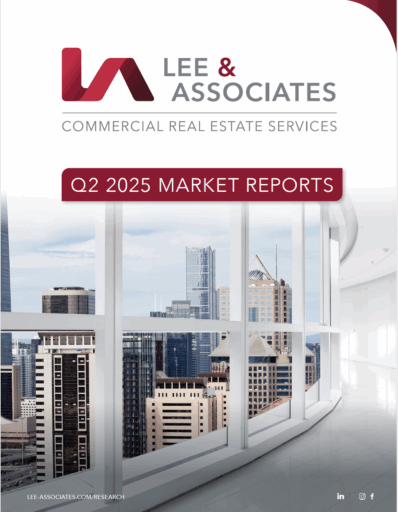INDUSTRIAL OVERVIEW: VACANCIES RISE, RENT GROWTH SLOWS
Concern over the impact of tariffs has added to slowing tenant growth in logistics and manufacturing across North America. But the continued easing demand has resulted in more choices and benefits for users that have been subjected to a prolonged stretch of steep rent growth.
Vacancies in the United States have risen to 7.4%, a decade-long high, while deliveries continued to outpace tenant expansion. Net absorption fell 8.1 million SF in the first half, including negative 5.9 million SF in the second quarter. Demand in Canadian markets – particularly for logistics properties – was 5.7 million SF in the red through June. Easing demand raised the vacancy rate to 4.2%, a 40-basis point increase from Q1.
Rent growth throughout Canada measured 1.3% in the second quarter, down from 7% a year ago and from an average of 8.6% since 2019. Meanwhile, overall rent growth in the U.S. year to date has fallen to 1.7% compared to 4.1% through the first half a year ago and an average of 7% in the last five years.
Nevertheless, due to record rent gains during the Covid years, many leases still are renewing at higher rates after being marked to market. This is seen chiefly with smaller spaces in the U.S., where available inventories remain tight. READ MORE >
OFFICE OVERVIEW: TENANT CONTRACTIONS RESUME
Overall recent improvement in tenant growth across North American office markets had been showing signs of a recovery with some momentum. But the first positive United States trend since Covid hit a wall in the second quarter while revised Canadian net absorption totals turned negative after three years of modest gains.
U.S. net absorption was in the red 16.3 million SF in Q2, reversing 11.7 million SF of tenant expansion in the three previous quarters. The contraction pushed up the vacancy rate 30 basis points to a record 14.2%.
Class A tenants relinquished 6.9 million SF of space in the second quarter, pushing up the vacancy rate 40 basis points to 21.2%. Class B buildings posted 8.2 million SF of negative net absorption. The Q2 vacancy rate ticked up 20 points to 12.7%.
There had been recent signs that the recovery could have staying power as long as economic conditions remained positive. Absorption in Class A buildings had been positive for only the second time since 2021 and older buildings, which had been steadily losing occupancy, saw absorption stabilized. With attendance rising gradually and job growth slowing, a slow recovery and elevated vacancy rates looked likely.
In capital markets, the values for investment-grade buildings aimed at traditional office tenants have fallen by up to half. Since 2022, institutions and REITs have been net sellers, giving private buyers and owner-users opportunities to capitalize on discounts that often are below replacement costs. Values are likely to dip further as more liquidity leads to another round of price discovery. READ MORE >
RETAIL OVERVIEW: WEAKENING DEMAND FALLS IN FIRST HALF
Overall demand for North American retail property moderated in the first half of 2025 with declining net absorption in the United States turning negative for the first time since during the Covid lockdown, in part due to increased bankruptcies and recent store closures.
Net absorption was negative 8,913,320 SF in the second quarter. That follows a first-quarter 7,089,219-SF contraction. Annual net absorption has been falling steadily since peaking at 70.8 million SF in 2021. There were 67 million SF absorbed in 2022, 43 million SF in 2023 and 22.2 million SF last year. Included in the current negative reading is a 24% increase from Q1 in the move-out rate to more than 108 million SF.
Move-outs, which include spaces subject to the bankruptcy process, averaged 84 million SF in the last three years. The jump is tied directly to space occupied by Big Lots, Conn’s, Joann, Forever 21, Party City, Red Lobster, T.G.I. Fridays and other merchants and restauranteurs that began working through severe financial and legal woes in the last 18 months.
Despite changing tastes and an upturn in brand-name tenants in distress, the nationwide market of 11.9 billion SF remains fundamentally tight in Q2 with overall vacancy at 4.3%, close to the historic low. The vacancy rate was 2.7% for general retail, the largest category with 6.5 billion SF or 55% of total inventory. Neighborhood centers totaled 2.9 billion SF for 24% of inventory and were at 6.3% vacancy. Strip and power centers totaled 1.5 billion SF and averaged just less than 5% vacancy. Malls totaled 876 million SF and were at 8.8% vacancy. READ MORE >
MULTIFAMILY OVERVIEW: REACTING TO DOWNTURN PREDICTIONS
While healthy multifamily tenant demand held steady in the second quarter across the United States, net absorption moderated in Canada amid reductions to national immigration quotas and growing concerns that the trade war with the U.S. will cause a recession.
Strong second-quarter net absorption in the U.S. totaled 136,007 units, as tenants shrugged off recession forecasts and extended the stretch of robust demand that began early last year. In the last six quarters 816,814 units have been leased up. New York and large markets in the South and Southwest, such as Dallas and Phoenix, have been growth leaders in the first half.
The Q2 decline in overall vacancy by 10 basis points to 8.1% is attributed to the higher quality Class A segment where demand has exceeded supply.
The solid rental demand through Q2 of 267,273 units follows the 548,911 units leased in 2024, the second most on record. Accelerated demand for apartments has been supported by steady employment and economic growth. Furthermore, older members of Gen Z are entering the prime apartment rental age, while more baby boomers are reaching an age where renting becomes a better option.
As apartment demand is growing at an above-average pace, the development cycle has peaked and is winding down. The annual inventory growth rate has fallen from 3.6% in 2024 to 1.3% through the first half, the lowest percentage since 2013. Net deliveries have declined for three consecutive quarters, falling nearly 30% to less than 130,000 units in the first quarter. Forecasts show that as few as 80,000 units are due for fourth-quarter delivery. Construction starts have fallen to a decade-plus low due to the extended lease-up periods developers are experiencing, higher capital costs and stricter lending. READ MORE >




